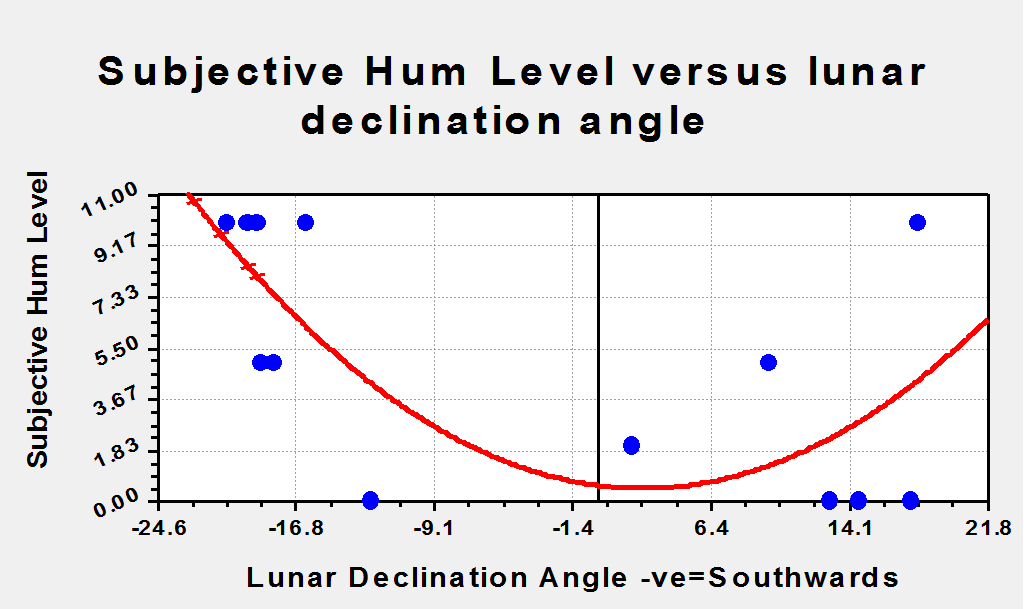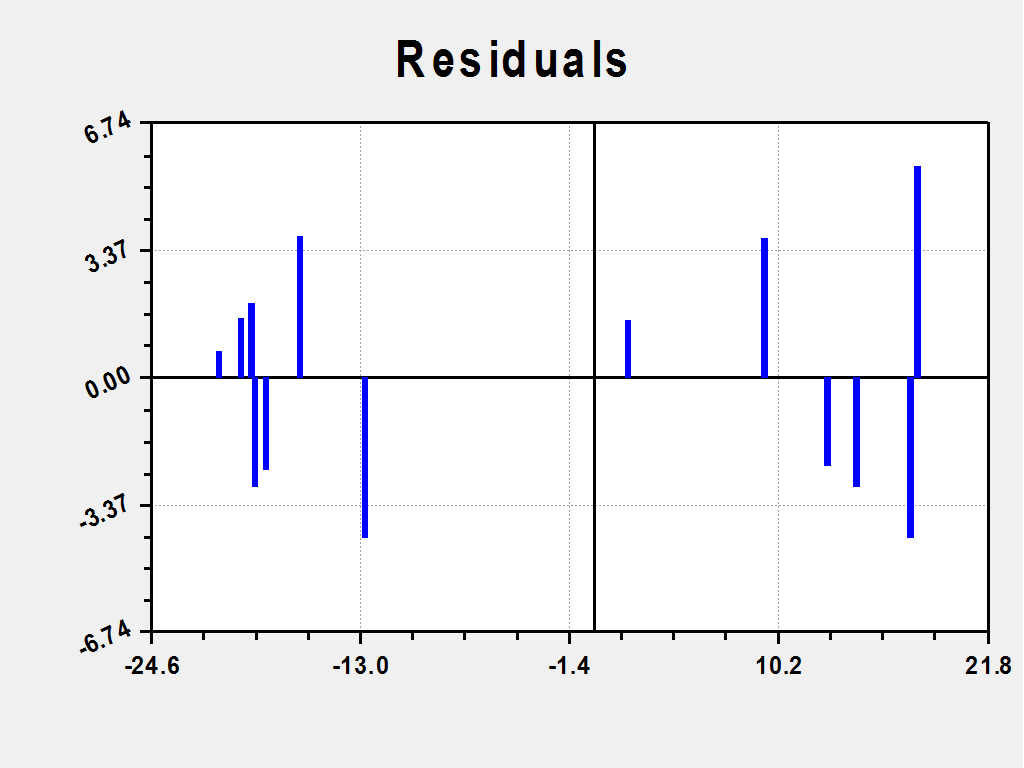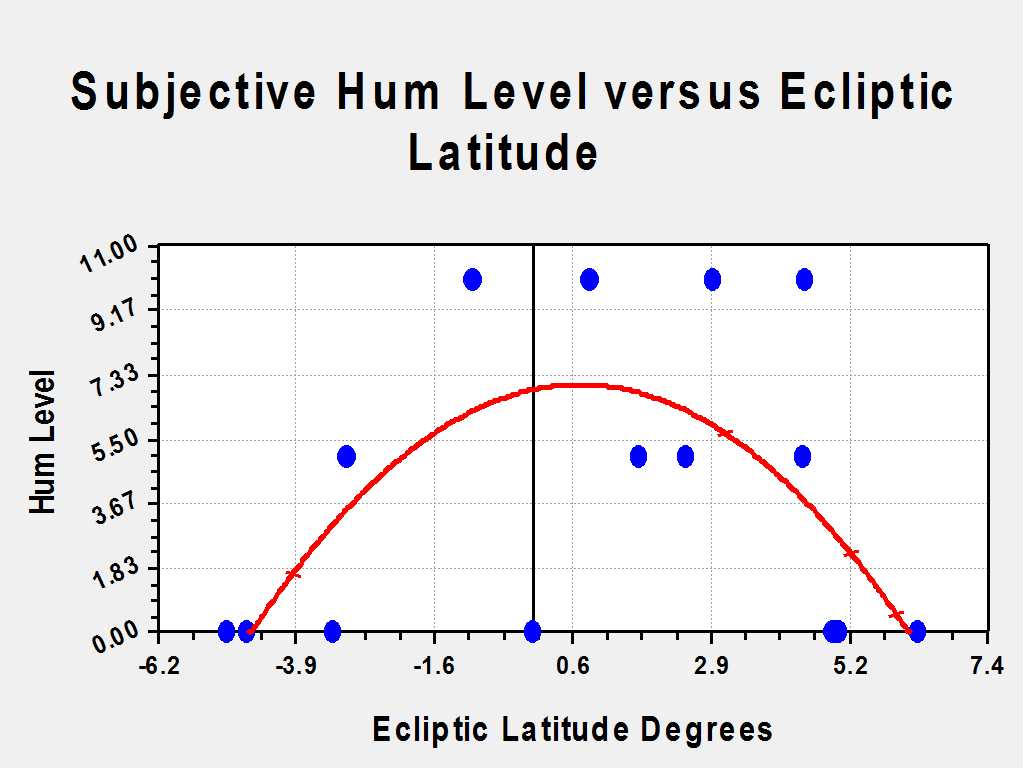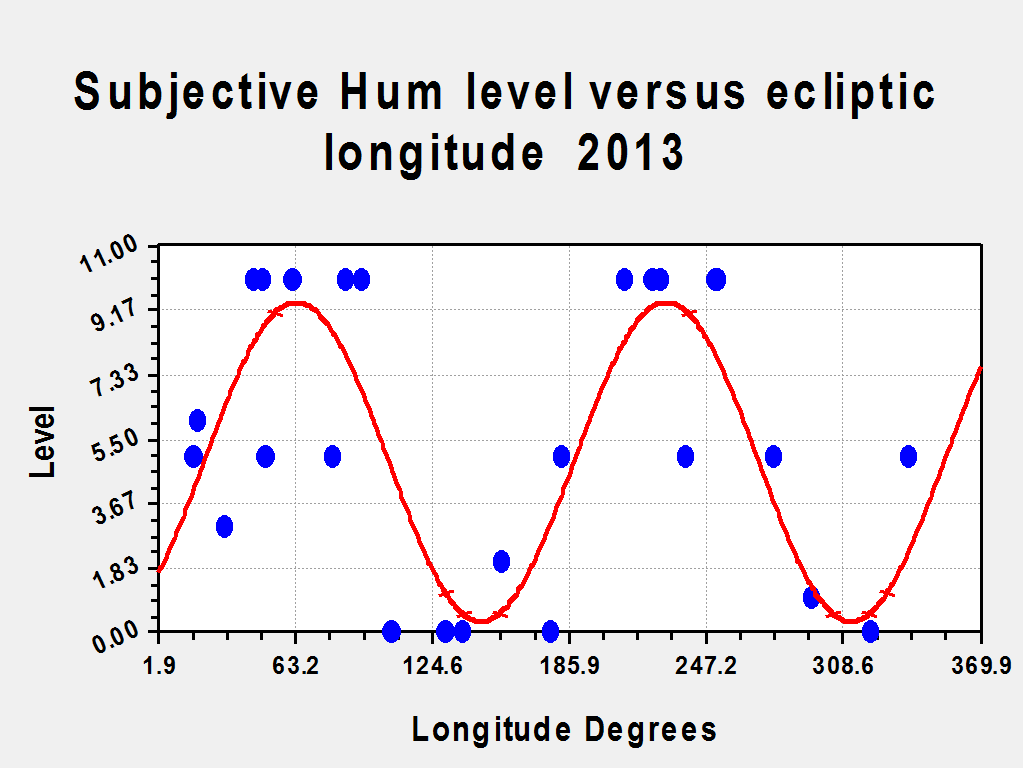
The Moon: Predictor of the Hum by Dr Chris Barnes, Bangor Scientific and Educational Consultants, e-mail doctor.barnes@univ.bangor.ac.uk November 2013
Dr Barnes Homepage http://www.drchrisbarnes.co.uk
Introduction
The Hum is a term given to a little known, acoustic, magneto-acoustic or gravito-acoustic phenomenon or possibly group of phenomena which behave in both as if it/they were simultaneously anthropogenic and preternatural. The Hum may conceivably affect between 2-11% of the World’s population. Those afflicted hear/perceive an irritating, sleep disturbing, yet often very subliminal, noise often described as like a misfiring idling diesel engine and mainly heard in buildings at night. The Hum has been tone matched at between 30-80 Hz with superimposed quasi-periodic modulations of .5-5Hz. The description of the noise is also associated with that described for infrasound. Because the first American Hum, namely the Taos Hum could not be audio recorded, the Hum has over the years taken on somewhat of a mysterious guise. New cases of the Hum continue to be reported worldwide. The most recent is in Hyde, Southampton, UK about 1 month ago.
The Hum was first reported in Britain in the 1970’s and in the USA in the 1990’s. Originally, some suggested that the Hum was associated with Western Military Defence systems since it was not reported in the former USSR or China. A minority of cases of the Hum have been solved or rather attributed to sources of infrasound, acoustic sound and vibration such as volcanic action on Hawaii or the Kokomo hum was due to industrial sources. Generally however the Hum is far more than just a noise and the majority of cases are rarely, if ever solved. Recently there have been cases of the Hum all over the World including in Russia and China and by using meta-analysis it seems to be geographically most associated with modern, renewable, smart grid style, energy infrastructure. Some have also tried associating the Hum with high pressure gas mains but Russia had these long before the Hum was reported there. Careful treatment of all known anecdotal reports of the Hum’s characteristics is suggestive that it may be a magneto-acoustic phenomenon and that some individuals may perceive it by senses in addition to just audition.
Modern electricity infrastructure can be a source of infrasound, acoustic sound, impulsive noise and electromagnetic energy at fundamental, sub-harmonic, inter-harmonic and harmonic and provide inter-area and intra-area quasi-period oscillations and microwave frequencies (for control and monitoring) and these various components are capable under some circumstances of being coherently related to each other. It is thus this feature of power systems which might make the Hum so pervasive.
Additionally, there is by exhaustive observation, somehow, a link between the Hum and the Earth’s geomagnetic parameters. This is certain as it has been shown that the Hum maximises under certain sets of geomagnetic conditions. The logical conclusion is that somehow the presumed power systems signals either modulate natural geomagnetic signals or vice versa to produce the Hum. This is not unlike the effect of ionopsheric heating which is not simply limited to HAARP and SURA but also happens for all high power domestic broadcast transmitters and for power line harmonic radiation. Such modulation could be possible in space i.e. the ionosphere, in the atmosphere or in the lithosphere or in all three. The latter is likely as they are all intimately coupled by both the geo-electric circuit and by acoustic gravity wave (AGW) interactions. It is of course very well known that power systems can be damaged by strong geo-magnetic storms.
The present author has previously shown that although the Hum is associated with periods of geomagnetic activity there are very specific periods within this activity associated with equal and opposite electrojet currents which maximise the Hum.
There are only two possible reasons for this. Firstly, injection of anthropogenic signals into the ionosphere might be easier. Secondly, there may be less random seismic noise under these conditions allowing the Hum seismic component to propagate more easily.
Lunar Predictor
It has been known since the 1960’s that the moon is a modulator of geomagnetic activity on earth, see Bigg (1963) and Bell and Defouw (1966). Lethbridge (1970) showed that the moon declination influenced total thunderstorm activity. One assumes there is a connection here with both geo-magnetism and the global electric circuit. Of course thunderstorms also generate infrasound and AGWS.
Much more recently, Fejer and Tracer have considered lunar tidal effects in the electrodynamics of the low latitude ionosphere which they have shown can be highly variable even in geomagnetically quiet times. Lunar tides over periods of hours can play a significant part in this variability. Interestingly, outbreaks of the Hum can last for several hours and coincide with east /west cancelation in the electrojet current streams (Barnes)
Zurbenko and Potrzeba (2013) discuss the wider issue of atmospheric tides of both lunar and solar origin in far more detail. They conclude their significance is far greater than previously anticipated in may events in the atmosphere. Perhaps even more reason to assume the moon and the Hum ought to be connected then? Lunar phase even has a small but statistically significant effect on daily global temperature; see Balling and Cerveny (1995).
The lunar cycle also modulates human sleep and melatonin levels, see Cajochen et al (2013).
There have been numerous anecdotal reports on Hum forums and the like that the Hum maximises at the time of full moon. The author has previously tried to account for such reports (refs). The present author also recently saw a posting on a Hum forum suggesting that the Hum perceived by on individual seemed to depend on the elevation of the moon, irrespective of its phase.
From the present author’s perspective while he has vaguely noticed the full moon effect he has also found the combined effect of the lunar phase and declination to be important but hasn’t until this present publication made a detailed evaluation.
Given all of the above it is reasonable in hypothesis to suggest that the Hum level ought to depend somehow on the moon by virtue of the latter’s effect on geomagnetism alone. Adjunctively to this will be gravitational effects of the moon on atmospheric tides and seismic signal propagation.
Experimental
The experimental subjects are the author and his wife. Although both describe the same Hum, the author’s wife generally perceives its return after a quiet period some 48-72h prior to the author. The average data set from both subjects is for the whole of 2013 to date making a purely subjective scale for the Hum as being 0 = not perceptible, 2= weak , 5= moderate and 10=strong (hard to screen). The subjective levels for various ‘Hum events’ across the year have been plotted against known moon parameters obtained from
http://time.unitarium.com/moon/where.html
The parameters used were respectively; moon declination angle, moon ecliptic latitude and moon ecliptic longitude.
A well known freeware curve fitting routine (Hyams) was employed.
Results and Discussion
Declination angle

The subjective Hum level was found to maximise for both maximum southern lunar declination angles of greater than 14 degrees especially if precisely coinciding with a new moon or first quarter moon. It is known that lunar phase and declination angles are not exactly in step due to precession. For positive declination angles in a waxing moon the Hum is not so severe. Lethbridge (1970) has noted increased thunderstorm activity for full moons with declination angles greater than 17 degrees north. It may be that the geomagnetic effect of this activity outweighs the anthropogenic effect which is the Hum?
Lethbridge (2012) has made a study of cosmic rays and thunderstorm frequency and has shown a decrease in thunderstorms at the time of high cosmic rays and an increase in thunderstorms 2–4 days later. This was done by superposed epoch analysis of thunderstorms over the eastern two thirds of the United States for 1957–1976. When data for spring and fall months were used, the minimum deepened. When high cosmic rays near full and new moon for these months were key days, the minimum deepened again and was significant at less than the 0.01% level. It is believed that when the Sun, Earth, and Moon are aligned, particulate matter in the lower stratosphere is modulated and acted upon by cosmic rays, bringing about an immediate decrease in thunderstorms. Cosmic rays also produce in increase in natural infrasound. Presumably augmenting the anthropogenic infrasound of the Hum?
This holds out promise for Hum sufferers as a means of prediction, a previous means of prediction proposed by the present author is space weather which is not known so far in advance as lunar cycles. It can be seen that the residuals (shown below) are larger for northward (positive) declination angles.

When this is explored in more detail the reason can be found. A new moon will produce serious augmentation of the Hum for +/- 2 days irrespective of declination but not if the declination is zero ( equatorial). A first quarter moon will produce Hum for +/- 2 days if declination is North and falling or rising. A full moon will only produce Hum for up to 4 days during and afterwards if its declination is Southwards and finally a 2nd quarter moon will produce Hum for up to +/- 4 days if the declination is Northwards and rising.
Thus in the Northern Hemisphere the best time to avoid the Hum is within +- 3 days or so of the most Northward Lunar Declination unless this coincides with a first quarter moon phase.
Ecliptic Latitude
There was an inverse parabolic relationship with ecliptic latitude. The Hum minimised quickly for ecliptic latitudes greater than a modulus of 4 degrees. This could be consistent with the observation of Bell and Defouw (1966) who found that geomagnetic activity was diminished when the moon was more than 4 degrees from the plane of the ecliptic. This result is strongly supportive of the theory that the Hum and geomagnetic activity are indeed inter-related.

Ecliptic Longitude
The subjective Hum level was shown to vary in a statistically significant sinusoidal manner across the full circle of ecliptic longitude (R=.8) but only for short periods 20-70 days depending on season. Presumably, precession is an issue and solar geomagnetic and weather effects outweigh the rest. Thus this holds out less promise of prediction.

Concluding remarks
A link has been shown between the Hum and the moon which to a certain extent holds some promise of prediction. The Hum in the Northern Hemisphere (Wales UK is always worse for large negative southwards pointing lunar declination angle.
Further work
Others have shown links between geomagnetism and the weather and between the moon and the weather and the moon and temperature. Thus the question is posed is there a relationship with the Hum. In that respect, monthly temperature anomaly which is well documented by the UK met office will be explored.